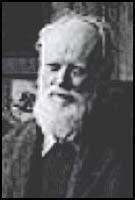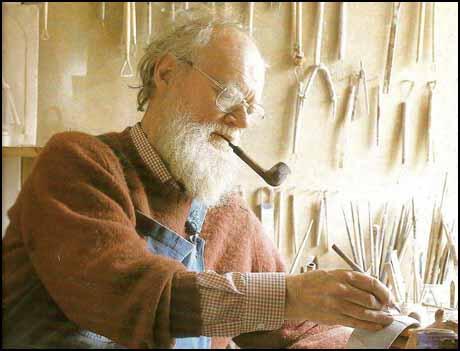Quentin Bell

Quentin Bell, the younger son of Clive Heward Bell and his wife, Vanessa Bell, the daughter of Leslie Stephen, and the sister of Virginia Woolf, was born on 19th August 1910. He was brought up in the family home at 46 Gordon Square and at Charleston Farmhouse, near Firle. Like his brother, Julian Bell, he was educated at Leighton Park School, the Quaker boarding-school in Reading.
A talented artist, Bell left school at seventeen and went on a tour of central European galleries with Roger Fry, the famous art critic. He spent periods of time painting in both Paris and Rome.
In 1933 Bell was forced to spend seven months in a sanatorium in Switzerland followed by convalescence near Monaco. In 1935 he returned to Italy and had his first exhibition at the Mayor Gallery. But later that year he decided to become a potter rather than a painter and enrolled himself at Burslem School of Art. While living in Stoke-on-Trent he became an active member of the Labour Party. Eventually he set up a studio at Charleston Farmhouse, where his artist mother Vanessa Bell and her former lover, Duncan Grant, also worked.
According to Leonard Woolf, Bell became a member of the Bloomsbury Group: "in the 1920's and 1930's when Old Bloomsbury narrowed and widened into a newer Bloomsbury, it lost through death Lytton (Strachey) and Roger (Fry) and added to its numbers, Julian, Quentin and Angelica Bell, and David (Bunny) Garnett."
His parents had been pacifists during the First World War. Bell was willing to joined the British Army after the outbreak of the Second World War but as was in poor health he was rejected on medical grounds. He therefore worked on the farm owned by John Maynard Keynes near Firle. He also joined his mother Vanessa Bell and her former lover, Duncan Grant, in providing wall-paintings at Berwick Church, that were completed in 1943. He was also employed by David Garnett in the political warfare department of the Foreign Office.
In 1947 Bell published his first major book, On Human Finery, a study of the history of fashion. He married the art historian, Anne Olivier Popham, on 16th February 1952. Soon afterwards he became a senior lecturer at King's College, Newcastle upon Tyne. He moved to Leeds Art School in 1959. He also taught at Slade Art School and Hull Art School before in 1967 becoming professor of the history and theory of art at Sussex University.
Bell had been a member of the Bloomsbury Circle, a group that included Virginia Woolf, Vanessa Bell , Clive Bell, John Maynard Keynes, Adrian Stephen, E. M. Forster, Leonard Woolf, Lytton Strachey, Desmond MacCarthy, Mary MacCarthy, Duncan Grant, Arthur Waley and Saxon Sydney-Turner. He was therefore in a good position to publish Bloomsbury (1968) and a two volume biography of his aunt, in his much acclaimed Virginia Woolf: A Biography (1972).

According to his biographer, Charles Saumarez Smith: "After retiring from his post at Sussex in 1975, Bell was able to spend more time and energy on his pottery. In 1985 he and his wife, Olivier, moved to a smaller house next door to the park in Firle and each morning he would wake up early and disappear to his kiln, only emerging for gin and ginger beer in the evening. He undertook a mixture of work, some rough, painted plates and mugs, which he saw as belonging to an artisan tradition, but also more ambitious ceramic sculpture. Neither style fitted comfortably within the work of contemporaries, as his pots were too utilitarian to be regarded as art and his ceramic sculpture too conventionally figurative. But this in no way deterred him from turning out a great amount of work which was both vigorous and affordable, a crossover between the Omega workshop and folk art."
Bell helped establish the Charleston Trust, which was responsible for saving his mother's house. Other books included a novel, The Brandon Papers (1985), a collection of essays and lectures in Bad Art (1989), and a series of character sketches, Elders and Betters (1995).
Quentin Bell died at his home, 81 Heighton Street, Firle, East Sussex, on 16th December 1996.
Primary Sources
(1) Leonard Woolf, Beginning Again (1964)
Then on Monday, July 3rd, only three weeks after I had arrived in England, I went and dined with Vanessa and Clive Bell in Gordon Square. I was alone with them at dinner, but afterwards Virginia, Duncan Grant, and Walter Lamb came in. This was, I suppose, so far as I was concerned, the beginning of what came to be called Bloomsbury.
What came to be called "Bloomsbury" by the outside world never existed in the form given to it by the outside world. For "Bloomsbury" was and is currently used as a term - usually of abuse - applied to a largely imaginary group of persons with largely imaginary objects and characteristics. I was a member of this group and I was also one of a small number of persons who did in fact eventually form a kind of group of friends living in or around that district of London legitimately called Bloomsbury. The term Bloomsbury can legitimately be applied to this group and will be so applied in these pages. Bloomsbury, in this sense, did not exist in 1911 when I returned from Ceylon; it came into existence in the three years 1912 to 1914 . We did ourselves use the term of ourselves before it was used by the outside world, for in the 1920's and 1930's, when our own younger generation were growing up and marrying and some of our generation were already dying, we used to talk of "Old Bloomsbury", meaning the original members of our group of friends who between 1911 and 1914 came to live in or around Bloomsbury.
Old Bloomsbury consisted of the following people: The three Stephens: Vanessa, married to Clive Bell, Virginia, who married Leonard Woolf, and Adrian, who married Karin Costello; Lytton Strachey; Clive Bell; Leonard Woolf; Maynard Keynes; Duncan Grant; E. M. Forster (who will be referred to in this book as Morgan Forster or Morgan); Saxon Sydney Turner; Roger Fry. Desmond MacCarthy and his wife Molly, though they actually lived in Chelsea, were always regarded by us as members of Old Bloomsbury. In the 1920's and 1930's, when Old Bloomsbury narrowed and widened into a newer Bloomsbury, it lost through death Lytton and Roger and added to its numbers Julian, Quentin, and Angelica Bell, and David (Bunny) Garnett, who married Angelica.
(2) Quentin Bell, Virginia Woolf: A Biography (1972)
It was a spring evening. Vanessa and I were sitting in the drawing room.... At any moment Clive might come in and he and I should begin to argue - amicably, impersonally at first; soon we should be hurling abuse at each other and pacing up and down the room. Vanessa sat silent and did something mysterious with her needle or her scissors. I talked egotistically, excitedly, about my own affairs no doubt. Suddenly the door opened and the long and sinister figure of Mr. Lytton Strachey stood on the threshold. He pointed his finger at a stain on Vanessa's white dress.
"Semen?" he said.
Can one really say it? I thought and we burst out laughing. With that one word all barriers of reticence and reserve went down. A flood of the sacred fluid seemed to overwhelm us. Sex permeated our conversation. The word bugger was never far from our lips.
(3) Victoria Glendinning, Leonard Woolf (2006)
In January 1966 Quentin Bell committed himself to writing the biography of Virginia Woolf. The starting point was obviously her diaries. Leonard posted off his manila envelopes containing the chopped-up sections of his carbon copies. He told Quentin that, with the extracts published in A Writer's Diary, he now had the lot. It was not so easy. The truncated pages sometimes had the dated portion cut off, and bits were missing. Fortunately Quentin's wife Olivier was a highly trained researcher, having been employed in her youth by eminent scholars to "get things right". She reconstituted the diaries, using Leonard's master-copy when in difficulties.
The work was made easier from early 1967 when Quentin was appointed professor of History and Theory of Art at the University of Sussex, and he and his family came to live at Cobbe's Place, within a couple of miles of, and roughly equidistant from, Charleston and Monks House. Leonard rooted out for them bundles and boxes of letters, including the copies of those he had sold. He was helpful but not controlling, exerting no pressures. Quentin sent Leonard a "Report on Preliminary Research" after one year: the main task had been to put the 300,000 words of the diary into "usable form". He and Olivier were preparing a biographical index and notes as they went along. They were also sorting the Charleston papers, and were planning to interview people who knew Virginia. Olivier constructed a system of card indexes and a chronology.

